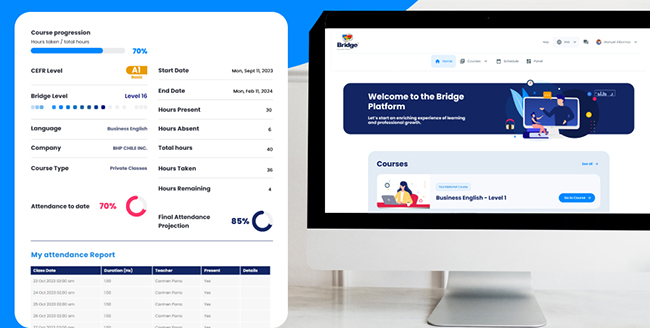The landscape of workplace learning is rapidly evolving, and corporate language training is no exception. As organizations recognize the importance of language skills in today’s globalized business environment, they are seeking innovative and effective solutions to upskill their workforce. In this article, we’ll explore the key trends shaping the future of corporate language training.
1.Personalized Learning Paths
One of the most significant trends in corporate language training is the shift towards personalized learning paths. By tailoring language learning experiences to individual employee needs and preferences, organizations can enhance engagement and improve learning outcomes. As Bridge Education Group’s Academic Director, Karina Zew, explains, “Personalized learning allows us to meet employees where they are in their language learning journey and provide targeted support to help them reach their goals. Our Hyper-Personalized Specialized Courses take the learner’s unique professional context, company-specific materials, and industry jargon to create lesson plans that directly apply to each employee’s work environment.” Carmen Parra, Bridge’s Key Account Manager, adds, “Our Hyper-Personalized Courses ensure that the language skills learners acquire are immediately relevant and applicable to their professional lives.”

2. Technology Integration
The integration of technology is transforming corporate language training. Digital platforms, mobile learning apps, and online language courses offer employees the flexibility to learn at their own pace and convenience. “We are seeing a growing demand for technology-enabled language training solutions,” says Natalia Bustos, Senior Account Manager at Bridge. “Our clients recognize the potential of these tools to enhance learner engagement and accelerate language acquisition.”
Bridge’s learning platform is at the forefront of this technological integration. The platform offers a personalized dashboard, detailed course syllabus, and live progress tracking to help learners navigate their language learning journey.
Learners can also connect with their teachers through online profiles and receive consistent feedback to accelerate their progress.
The platform also provides interactive course materials and videos, ensuring an engaging learning experience. Learners can also earn blockchain-protected digital badges to showcase their achievements.

3. Gamification and Microlearning
Gamification elements, such as leaderboards, badges, and rewards, are being incorporated into corporate language training programs to make learning more engaging and enjoyable. Microlearning, which involves delivering bite-sized language lessons, allows employees to learn on the go and fit language studies into their busy schedules. “Gamification and microlearning are powerful strategies for keeping learners motivated and focused,” notes Zew. “By breaking down language learning into manageable chunks and adding elements of fun and competition, we can create a more effective and enjoyable learning experience.”
Bridge has embraced gamification through the introduction of Digital Badges. These blockchain-backed credentials showcase learners’ language proficiency achievements in a modern, secure, and verifiable way. Learners earn a digital badge for every 45-hour module they complete, with each module aligned to internationally recognized proficiency standards such as the CEFR (Common European Framework of Reference) and the GSE (Global Scale of English). The badges reflect learners’ progress and can be easily shared on social media platforms, digital resumes, or anywhere else trainees want to showcase their language skills. “Our Digital Badges are a game-changer in terms of learner motivation and engagement,” says Georgina Mazzarella, Corporate Account Executive at Bridge. “By providing a tangible reward for their efforts and a way to share their achievements with others, we’ve seen a significant increase in learner participation and completion rates.”
4. Social and Collaborative Learning
Language learning is increasingly being viewed as a social and collaborative process. Corporate language training programs are incorporating more opportunities for learners to interact with each other, practice their language skills in real-life scenarios, and learn from their peers. “Social and collaborative learning activities not only improve language proficiency but also foster teamwork, communication, and problem-solving skills,” says Zew. “These are critical skills that translate directly to the workplace.”
Bridge’s Conversation Connection Specialized Course is an excellent example of this trend in action. Designed for B1 and B2 level learners, this program focuses on learning through conversations and group dynamics, connecting learners with other professionals who share their level of English proficiency. Participants engage in a variety of interactive activities, such as dynamic games, management topic debates, discussions of current events, problem-solving exercises, presentations, and cultural exchanges. “Conversation Connection offers a unique opportunity for learners to practice their English skills in a social and business-oriented environment,” explains Umut Erzog, Teacher Experience Manager at Bridge. “By combining language learning with professional networking and cultural exchange, we’ve created a truly immersive and collaborative learning experience that accelerates language acquisition and builds essential workplace skills.”

5. Alignment with Business Goals
Corporate language training programs are increasingly being designed to align with specific business goals and objectives. By identifying the language skills that are most critical for success in different roles and departments, organizations can create targeted training programs that directly support their business strategies. “Aligning language training with business goals is essential for maximizing the return on investment,” notes Carlos Pizarro, LATAM Regional Director at Bridge. “When employees acquire the language skills that are directly relevant to their work, they are better equipped to communicate effectively, collaborate with global teams, and drive business results.”
Bridge takes a proactive approach to aligning language training with business goals through a Language Needs Assessment. This comprehensive evaluation process involves close collaboration with corporate clients to explore the need for language training among different departments and job functions, identifying specific skill gaps and areas for improvement. By gathering this information, Bridge is able to design a customized training program that meets the client’s specific needs and objectives. “Our Language Needs Assessment is a critical first step in creating a truly effective corporate language training program,” says Bustos. “By taking the time to understand each client’s unique business goals and language requirements, we can develop a tailored curriculum that maximizes the impact of the training and delivers measurable results.”
As the corporate language training landscape continues to evolve, language training providers must stay at the forefront of these trends. By leveraging personalized learning paths, technology integration, gamification, microlearning, social learning, and alignment with business goals, these providers can deliver cutting-edge language training solutions that meet the needs of today’s global workforce.
Sources:
- eLearning Industry. (2024). L&D Trends 2024: The Future of Workforce Learning and Effective Measurement. https://elearningindustry.com/ld-trends-2024-future-of-workforce-learning-and-effective-measurement-ebook-release
- EI Design. (2024). Future Workforce Learning Trends in 2024. https://www.eidesign.net/ld-trends-in-2024-shaping-future-workforces-and-optimizing-learning-as-a-business/

